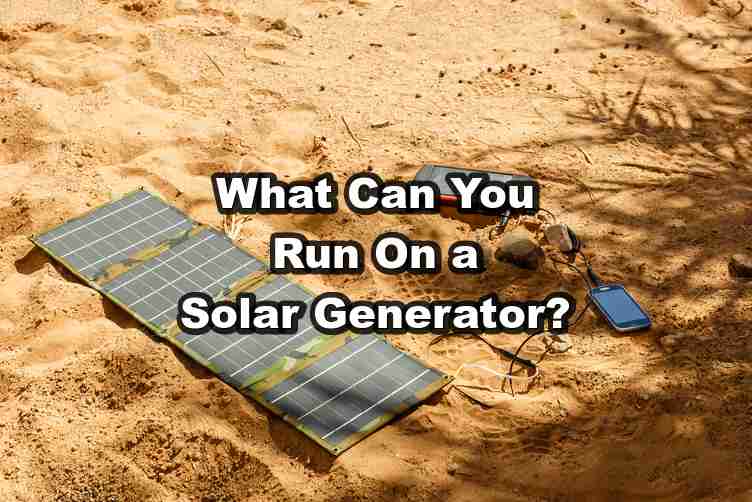Solar generators can power a surprising range of devices and appliances, making them versatile solutions for emergencies, outdoor activities, and off-grid living. These portable power stations convert sunlight into electricity and store it in batteries, allowing you to run everything from smartphones and laptops to refrigerators and medical devices without traditional fuel.
Unlike gas generators, solar generators operate silently with zero emissions, providing clean energy whenever and wherever you need it.
The key to successfully using a solar generator lies in understanding its battery capacity limitations and matching them to your power needs. While a 2000W model can easily handle multiple small appliances simultaneously, high power load devices like space heaters or air conditioners may quickly drain even high-capacity units.
Some situations might call for a more conventional approach, like a dual-fuel Duromax generator. However, with a single charge, you may be able to run a small mini-fridge on a solar generator for days or get several hundred charges for your mobile phone or laptop.
Most modern solar generators feature various output options including standard AC outlets, DC ports, and USB connections to accommodate different devices.
Whether preparing for power outages, planning a camping trip, or seeking energy independence, knowing precisely what appliances your solar generator can run—and for how long—will help you select the right model and manage your power expectations effectively.
Key Takeaways
- Solar generators can power most household electronics, from phones and laptops to refrigerators and CPAP machines.
- Consider both running wattage and starting surge requirements when matching appliances to your generator’s capacity.
- A mid-sized 1000-2000W solar generator can run essential appliances during emergencies but not energy-intensive heating or cooling systems.
- Battery capacity (measured in watt-hours) determines how long your devices can operate before recharging is necessary.
- Multiple charging options, including solar panels, wall outlets, and car chargers, provide flexibility for keeping your generator powered.
What Can You Power with a Solar Generator? Common Appliances and Wattage Requirements
When considering what you can run on a solar generator, it’s important to understand the power requirements of various appliances and devices. Solar generators come in different sizes and capacities, which determine what they can effectively power. Here are some common items you might want to run on a solar generator, along with their typical starting and running wattages:
| Appliance or Device | Starting Wattage | Running Wattage |
|---|---|---|
| Refrigerator (Energy Star) | 1200W | 200W |
| Microwave Oven | 1000W | 1000W |
| Coffee Maker | 1000W | 1000W |
| Laptop Computer | 100W | 100W |
| 32″ LED TV | 50W | 50W |
| Box Fan | 200W | 100W |
| Smartphone Charger | 15W | 15W |
| LED Light Bulb (60W equivalent) | 10W | 10W |
| Sump Pump (1/2 HP) | 2000W | 1000W |
| Electric Grill | 1500W | 1500W |
As you can see, the starting wattage is often higher than the running wattage for many appliances. This is because devices like refrigerators and pumps require an extra surge of power to start up before settling into their normal running wattage. When choosing a solar generator, you’ll need to consider both the starting and running wattages of the items you plan to power.
For example, if you want to run a refrigerator, microwave, and a few lights during a power outage, you’ll need a solar generator with a continuous output of at least 1500W and a surge capacity of around 3000W to handle the starting wattages. A smaller 1000W generator might be sufficient for charging laptops, phones, and running some LED lights while camping.
It’s also important to note that the actual power consumption of appliances can vary based on factors like size, model, and efficiency. The wattages listed above are general estimates, so it’s always a good idea to check the specific power requirements of your devices before choosing a solar generator.
In addition to the generator’s output capacity, you’ll also need to consider the battery storage capacity, which determines how long you can run your appliances. A generator with a larger battery (measured in watt-hours) will be able to power your devices for a longer period before needing to be recharged.
By understanding the power needs of common appliances and matching them to the capabilities of different solar generators, you can find the right setup for your specific use case, whether it’s powering essential items during an emergency, running a campsite, or living off-grid.
Check out our articles about the pros and cons of a solar generator for more info.
Conclusion
Solar generators offer remarkable versatility in powering a wide spectrum of devices and appliances, from essential electronics to moderate household items. Their ability to harness renewable energy makes them invaluable for emergency preparedness, outdoor adventures, and sustainable living solutions.
By understanding the wattage requirements of your specific devices and matching them to an appropriately sized generator, you can create a reliable power system tailored to your needs.
When selecting a solar generator, focus on both power output capacity and battery storage. A generator with 1000-2000W output and 1000-2000Wh storage will handle most essential needs during outages, while larger systems may be necessary for powering multiple appliances simultaneously or running high-wattage devices.
Remember that environmental factors like available sunlight will affect recharging efficiency, so having alternative charging methods is always advisable.
Take the next step toward energy independence by calculating your specific power requirements and exploring solar generator options that align with your usage patterns.
Whether you’re looking to keep essential devices running during emergencies or seeking a clean energy solution for your outdoor lifestyle, the right solar generator can transform how you think about portable power while reducing your environmental footprint.

Leave a Reply